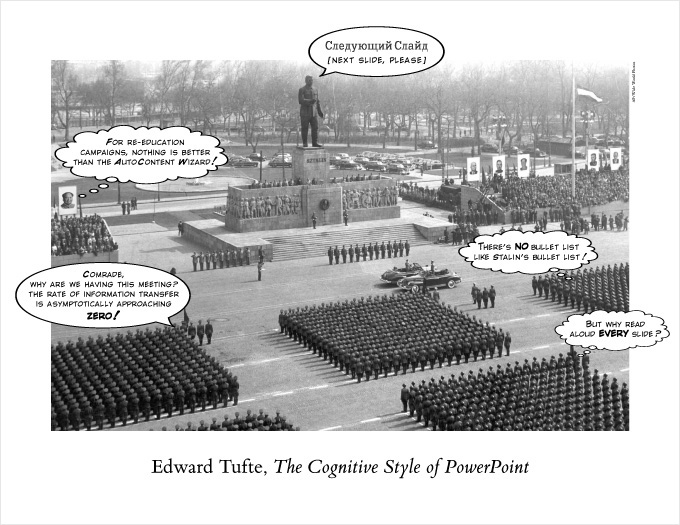 Edward Tufte‘s passion is the graphical display of information. But his nemsis the visual lie. So naturally, he has a special dislike for PowerPoint. His poster on The Cognitive Style of PowerPoint gave me this line, which I will likely find myself repeating at a time when it is both most accurate and most politically suicidal to do so:
Edward Tufte‘s passion is the graphical display of information. But his nemsis the visual lie. So naturally, he has a special dislike for PowerPoint. His poster on The Cognitive Style of PowerPoint gave me this line, which I will likely find myself repeating at a time when it is both most accurate and most politically suicidal to do so:
Why are we having this meeting? The rate of information transfer is asymptotically approaching zero.
He’s working on a new book, Beautiful Evidence, and he’s posted a few chapters-in-progress: Corrupt Techniques in Evidence Presentations. His list of suspects: bullet lists, quotes without context, lying graphs and charts.
So now I have to re-do my presentations. I do my best to avoid charts and graphs, but bulleted lists and pull quotes are a staple of mine. One of the commentors remarked that the criticism may be a little harsh:
Bullet points abbreviate by design and often they do give the what rather than the why; that’s because a good speaker should fill in the gaps. You say that an appropriate tool is the sentence; that is, hopefully, what the speaker will be using to communicate with their audience.
I imagine Tufte’s suggestion — based on his PowerPoint essay — would be to use them carefully, and shift emphasis to detail handouts that have more information (and fewer of the problems) of a PowerPoint slide. However, never ever hand out a printed PowerPoint presentation.
People see, read, and think all the time at intensities vastly greater than those presented in printed PowerPoint reports. …Report writers should have the courtesy to write a real report (which might also be handed out at a meeting) and address their readers as serious people.
In short, if you are compelled to use a projector during your presentation, at least don’t let it distort the content of the presentation. I look forward to the full release of Beautiful Evidence for more tips. Until then, I’ll have to re-read The Cognitive Style of PowerPoint, and examine, as Tufte suggests, the third chapter of Visual Explanations.